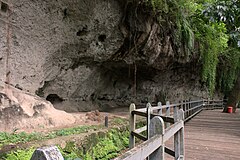Angono Petroglyphs
| Mga Petroglipo ng Angono | |

Petroglyphs on a rock wall, Rizal, Philippines
|
|
| Alternate name | Petroglyphs of the Rock-shelter Angono-Binangonan Petroglyphs |
|---|---|
| Location | Angono, Binangonan and Antipolo, Rizal, Philippines |
| Coordinates | 14°31′58″N 121°11′12″E / 14.532872°N 121.18679°ECoordinates: 14°31′58″N 121°11′12″E / 14.532872°N 121.18679°E |
| Type | Cave |
| History | |
| Periods | Neolithic Period |
| Management | National Museum of the Philippines |
The Angono Petroglyphs (Filipino: Mga Petroglipo ng Angono) is the oldest known work of art in the Philippines located in the province of Rizal. There are 127 human and animal figures engraved on the rockwall probably carved during the late Neolithic. These inscriptions clearly show stylized human figures, frogs and lizards, along with other designs that may have depicted other interesting figures but erosion may have caused it to become indistinguishable. The engravings are mostly symbolic representations and are associated with healing and sympathetic magic.
The site has been declared by the National Museum of the Philippines as a National Cultural Treasure in 1973. It is also included in the list of the World Inventory of Rock Art in 1985 and historic sites of the World Monuments Watch and World Monuments Funds and part of the Philippines' tentative list of the UNESCO World Heritage Site.
The existence of a rock shelter was reported to the National Museum by the late National Artist of the Philippines Carlos V. Francisco in March 1965 during a field trip with several boy scouts along the boundaries of Angono, Binangonan and Antipolo of the province of Rizal. Since then, some rock carvings have been damaged due to neglect and vandalism. In 1973, by virtue of Presidential Decree No. 260, it was declared as a national cultural treasure by the Philippine government. During that time, a team led by the National Museum of the Philippines started archaeological site conservation and site development of the petroglyphs in which a mini-museum, view deck and stone path, among others, were constructed. It was included in the list of National Cultural Treasures in 1973 and World Inventory of Rock Art in 1985. In 1996, The World Monuments Fund included Angono Petroglyphs on its list of preservation projects and has helped with the installation of a drainage system and assigned a caretaker to protect the site. The site is also on the tentative list of UNESCO World Heritage Sites of the Philippines.
...
Wikipedia

